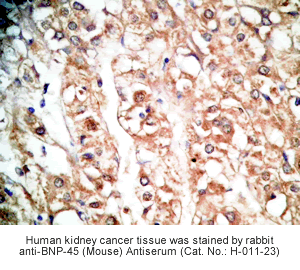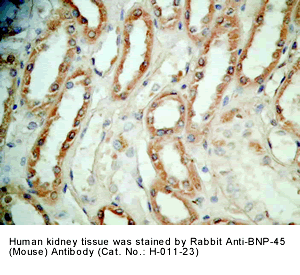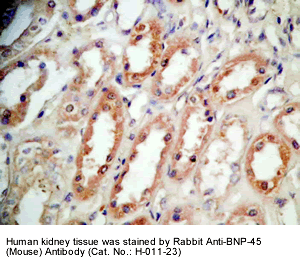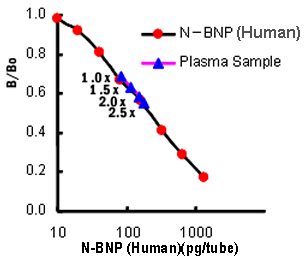OBJECTIVE: To evaluate whether measurements of N-terminal pro-brain natriuretic peptide (NT-proBNP) can be used to differentiate patients with normal and reduced left ventricular ejection fraction (LVEF) in an unselected consecutive group of hospital inpatients.
SETTING: City general hospital, Copenhagen, Denmark. Patients and design: During a 10 month period 2230 admissions to a city general hospital (80% of targeted patients) had an echocardiographic evaluation of left ventricular function, a comprehensive clinical evaluation, and blood analysis of N-terminal-pro-brain natriuretic peptide (NT-proBNP) within 24 hours of admission. Exclusions resulted from lack of informed consent or failure to obtain the required evaluations before death or discharge from hospital. Echocardiography was unsatisfactory in 37 patients, so the final number studied was 2193.
RESULTS: A raised NT-proBNP (>/= 357 pmol/l) identified patients with an LVEF of 40% was more than 97%. This probability rapidly decreased to 70% as the measured NT-proBNP increased to 150% of the predicted value.
CONCLUSIONS: A single measurement of NT-proBNP at the time of hospital admission provides important information about LVEF in unselected patients.
Bay M, et al. Heart 2003 Feb;89(2):150-4
BACKGROUND: Neither profiles nor prognostic values of neurohormonal markers have been prospectively evaluated in patients with acute myocardial infarction (AMI) undergoing primary angioplasty.
METHODS AND RESULTS: In 118 consecutive patients with AMI undergoing successful reperfusion (TIMI 2 and 3) by primary angioplasty, plasma concentrations of norepinephrine, epinephrine and N-terminal proBNP (NT-proBNP) were measured before, 60 min and 10 days after angioplasty. Catecholamine concentrations (mean+/-SEM) rose to a maximum in the first hour after angioplasty (norepinephrine: 602+/-44ng/L, epinephrine: 213+/-24ng/L) and returned to normal at day 10. Conversely, NT-proBNP levels maintained a further increase from 799+/-44pmol/L at baseline to 924+/-54pmol/L at day 10. A NT-proBNP concentration above median at 60 min post-angioplasty predicted major adverse cardiac events (n=27) during the 18-36 month follow-up with an odds ratio of 5.9 (1.7-20.3) and was superior to catecholamines, to left ventricular ejection fraction and to other established postinfarction risk markers.
CONCLUSIONS: In a low-risk cohort of patients with AMI undergoing successful reperfusion therapy, plasma NT-proBNP concentrations are elevated for at least ten days. The prognostic value of early plasma NT-proBNP should be further evaluated concerning its ability to facilitate risk stratification of infarct patients.
Hartmann F, et al. Z Kardiol 2003 Jan;92(1):73-81
A fast-acting and inexpensive blood test could help determine who will face the biggest risk of long-term complications after a heart attack or chest pain. New research shows the test provides a better indication of a patient's risk of death after such major heart problems than other currently available methods. When the heart becomes overloaded, it secretes a hormone called B-type natriuretic peptide (BNP), which acts like a natural diuretic to help the heart's function return to normal. In recent years, screening for levels of BNP has become a common way for emergency room staff to diagnose heart failure quickly and start treatment faster. But now researchers say that analyzing levels of a fragment of this hormone known as the N-terminal fragment (N-BNP) can more accurately predict long-term risks in patients with heart attack or chest pain (angina) than looking at BNP alone. They found that patients with the highest levels of N-BNP had twice the risk of dying than those with the lowest levels. Their study appears in today's rapid access issue of Circulation: Journal of the American Heart Association. Study researcher Kenneth Caidahl, MD, PhD, professor of clinical physiology at the Sahlgrenska University Hospital in Goteborg, Sweden and colleagues measured N-BNP levels in 609 patients with heart attack or chest pain (also known as acute coronary syndromes or ACS) that were admitted to the hospital between 1995 and 2000. After an average of about four years of follow-up, they found that N-BNP levels were significantly lower in survivors than those who had died during the study. And the risk associated with high N-BNP levels continued to be significant even after adjusting for the patient's age or history of heart failure. Researchers say the findings are especially significant because this marker also predicted the risk of death even among patients without any other measurable signs of damage to the heart. In an editorial that accompanies the study, James A. de Lemos, MD, of the University of Texas Southwestern Medical School in Dallas and David A, Morrow, MD, MPH, of Brigham and Women's Hospital in Boston, say the results many important questions about the use of BNP as an indication of heart risk. They write that the "magnitude of risk relationship associated with BNP appears to be greater than that associated with most currently available markers. Clearly, BNP is telling us something that we did not previously know about factors associated with risk in patients with ACS."
Jennifer Warner. WebMD Medical News. (Nov. 11, 2002)
Background: B-type natriuretic peptide (BNP) is a predictor of short- and medium-term prognosis across the spectrum of acute coronary syndromes (ACS). The N-terminal fragment of the BNP prohormone, N-BNP, may be an even stronger prognostic marker. We assessed the relation between subacute plasma N-BNP levels and long-term, all-cause mortality in a large, contemporary cohort of patients with ACS.
Methods and Results: Blood samples for N-BNP determination were obtained in the subacute phase in 204 patients with ST-elevation myocardial infarction (MI): 220 with non-ST segment elevation MI and 185 with unstable angina in the subacute phase. After a median follow-up of 51months, 86 patients (14%) had died. Median N-BNP levels were significantly lower in long-term survivors than in patients dying (442 versus 1306 pmol/L; P < 0.0001). The unadjusted risk ratio of patients with supramedian N-BNP levels was 3.9(95% confidence interval, 2.4 to 6.5). In a multivariate Coxregression model, N-BNP (risk ratio 2.1 [95% confidence interval,1.1 to 3.9]) added prognostic information above and beyond Killip class, patient age, and left ventricular ejection fraction. Adjustment for peak troponin T levels did not markedly alter the relation between N-BNP and mortality. In patients with no evidence of clinical heart failure, N-BNP remained a significant predictor of mortality after adjustment for age and ejection fraction (risk ratio, 2.4 [95% confidence interval, 1.1 to 5.4]).
Conclusions: N-BNP is a powerful indicator of long-term mortality in patients with ACS and provides prognostic information above and beyond conventional risk markers.
Omland T., et al. Circulation 2002, 10.1161/01.CIR.0000041661.63285.AE
BACKGROUND: Brain natriuretic peptide (BNP) levels have been used to assess clinical status and predict prognosis of patients with chronic heart failure (CHF). However, BNP levels can only be measured in specialized laboratories which has hampered its use in daily clinical practice. We compared a new, rapid, BNP assay with a conventional BNP measurement and evaluated the applicability to current practice by comparing it with standard clinical parameters.
METHODS: BNP levels were determined in 78 stable CHF patients and 20 controls. The severity of CHF was assessed by determination of New York Heart Association functional class (NYHA), left ventricular ejection fraction (LVEF) and peak oxygen consumption (peak VO(2)), and these parameters were compared to BNP levels.
RESULTS: Overall, rapid BNP assessment was highly correlated with the conventional BNP assay (r=0.95, P < 0.0001). In the higher ranges (>200 pmol/l), however, correlation was less accurate, and tended to overestimate. BNP levels also strongly correlated with both NYHA class, LVEF and peak VO(2) (all P < 0.001). A cut-off value for BNP of 20 pmol/l yielded a sensitivity of 91% and a specificity of 92% to detect the presence of left ventricular systolic dysfunction.
CONCLUSIONS: Rapid measurement of BNP levels is comparable to conventional BNP measurement and strongly correlated to clinical tests that are currently used to stratify CHF patients. Wider use of this method may yield a reduction of costly and time-consuming clinical tests and may reduce the medical burden of CHF.
Tjeerdsma G,, et al. Int J Cardiol 2002 Dec;86(2-3):143-9
It is not clear whether brain natriuretic peptide (BNP) or N-terminal proBNP (NT-proBNP) is superior as a diagnostic and prognostic indicator in cardiac diseases. Here, we compare the clinical correlations of both peptides in a population of 92 ambulatory patients with heart failure, using a well-established immunoradiometric assay (IRMA) for BNP and an automated electrochemiluminescence immunoassay for NT-proBNP. The analytical correlation between the two peptides was satisfactory over a wide range of concentrations (1-686 pM for BNP) with the equation: NT-proBNP = 3.48 x BNP -19 and a correlation coefficient r2=0.94. In addition, the concentration of both peptides increased in a similar fashion according to the severity of the disease New York Heart Association (NYHA) functional class, left ventricular ejection fraction, etiology) and age; for instance, the ratios between median levels measured in NYHA class III vs. class II patients were comparable for BNP (383 vs. 16 pM, ratio 24) and NT-proBNP (1306 vs. 57 pM, ratio 23). We conclude that N-terminal proBNP, as assayed in the present study, correlates equally to BNP with clinical variables in patients with heart failure.
Masson S, et al. Clin Chem Lab Med 2002 Aug;40(8):761-3
BACKGROUND: B-Type natriuretic peptide (BNP), a protein released from the left ventricle in response to volume expansion and pressure overload, has emerged as the first whole blood marker for the identification of individuals with congestive heart failure (CHF). OBJECTIVE: The purpose of this study was to assess the performance of a point-of-care assay to diagnose and evaluate the severity of CHF on the basis of the New York Heart Association (NYHA) classification system.
METHODS: Through a prospective, multicenter trial, whole blood samples were collected from a total of 1050 inpatients, outpatients, and healthy control patients. Participants were divided into subgroups for BNP analysis: patients without cardiovascular CHF (n = 473), patients with hypertension and no cardiovascular disease (n = 168), NYHA class I CHF (n = 73), class II CHF (n = 135), class III CHF (n = 141), and class IV CHF (n = 60).
RESULTS: Circulating BNP concentrations determined from the bedside assay increased with CHF severity, as determined by the NYHA classification system, but were only statistically significant (P < .001) between individuals with and without CHF. Individuals without CHF had a median BNP concentration of 9.29 pg/mL. Median BNP values, with their corresponding interquartile ranges, for NYHA classification I through IV were 83.1 pg/mL (49.4-137 pg/mL), 235 pg/mL (137-391 pg/mL), 459 pg/mL (200-871 pg/mL), and 1119 pg/mL (728->1300 pg/mL), respectively. With the use of a decision threshold of 100 pg/mL, the assay demonstrated 82% sensitivity and 99% specificity for distinguishing control patients and patients with CHF.
CONCLUSIONS: BNP concentrations obtained from whole blood samples are useful in the diagnosis of CHF and staging the severity of the disease.
Wieczorek SJ., et al. Am Heart J 2002 Nov;144(5):834-9
Acute hypotension, transient hypoxaemia and elevation of pulmonary artery pressure are well known to occur during cemented arthroplasty. The aim of this prospective clinical study was to characterize the relationship between plasma concentrations of atrial and brain natriuretic peptides (ANP, BNP), and changes in blood pressure in patients undergoing hip arthroplasty. Elevated ANP and BNP levels may be markers of inadequate myocardial reserve. We measured plasma ANP and BNP levels before the operation and 20 minutes after the cementing in 18 patients (54-90 yr). We defined a hypotensive response after cementing as a decrease in systolic blood pressure of more than 15 mm Hg below the pre-cementing value. In the hypotensive group, preoperative values of ANP were 123+/-48.5 pg/ml and BNP, 138+/-71.7 pg/ml. These values are significantly greater than those in the normotensive group (ANP 35.9+/-7.7, and BNP 17.2+/-3.2 pg/ml). High preoperative values of ANP and BNP are associated with more hypotension during cemented arthroplasty and could provide an indication of which patients are at risk of this complication.
Terasako K. Anaesth Intensive Care 2002 Oct;30(5):588-90
A blood test that would aid in the diagnosis and management of patients with congestive heart failure would have a favorable impact on the staggering costs of the disease. B-type naturetic peptide (BNP) is synthesized in the cardiac ventricles and its release is directly proportional to ventricular volume expansion and pressure overload. Levels of BNP correlate with left ventricular pressure, amount of dyspnea, and the state of neurohumoral modulation. BNP also correlates closely with New York Heart Association classification. A cut point of 100 pg/mL appears to discriminate patients with congestive heart failure from those without congestive heart failure. Measurement of BNP may also be an excellent screening tool for LV dysfunction.
Maisel A. Cardiovasc Toxicol 2001;1(2):159-64
Concentrate plasma sample in 1.5x, 2.0x and 2.5x: lyophilized 150ul, 200ul and 250ul plasma and
rehydrate it in 100ul RIA buffer. (Cat. No.:
RK-011-42) Preliminary results from our laboratory
showed fresh N-BNP plasma level in healthy subjects =714 ±
19.9 pg/ml (Mean ± SD, n=16). This level may vary from
laboratories. This kit is intended for research use only.




Tissue Sample |
Human kidney cancer and kidney tissues |
Fixative |
10% formalin |
Embedding |
Paraffin |
Negative Control |
No primary antibody |
Pretreatment |
N/A |
Blocking |
3% H2O2, 2% Normal Goat Serum |
Primary Antibody |
Rabbit anti-BNP-45 (Mouse) Antiserum (Cat. No.: H-011-23) |
Optimal Dilution |
1: 500 |
Secondary Antibody |
Goat Anti-Rabbit IgG, Biotinylated (1:400), 30 min |
Amplification |
Streptavidin-HRP (Vector), 1:400, 30 min |
Detection System |
HRP |
Substrate |
DAB (Sigma), 3 min |
Counterstained |
Hematoxylin, 30 sec |
Preliminary results from our laboratory showed fresh N-BNP plasma level in healthy subjects =714 ± 19.9 pg/ml (Mean ± SD, n=16). This level may vary from laboratories. These kits are intended for research use only.
See other peptide level in normal human plasma: Normal Plasma Peptide Levels



